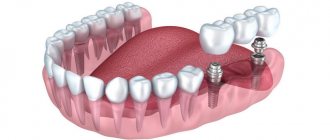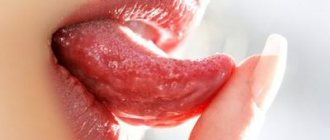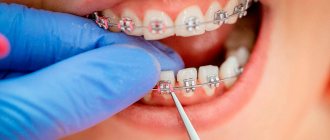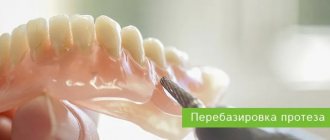Possible causes Problems with the crown on the pin The crown on the implant is loose Temporary crowns How to eliminate risks
“ Doctor, my crown on my tooth is loose, what should I do?
” This question is not uncommon in the dental office. Patients do not always understand why, instead of simply fixing the crown, the doctor prescribes an examination.
The orthopedist’s task is not just to fix the prosthesis, but to find out the reason why the crown is loose after installation.
Without an examination, it is impossible to make an accurate diagnosis, and if the cause is not eliminated, the problem will arise again and again.
What causes the crown to become loose?
Part of the dental examination is taking an anamnesis, especially if the denture is several years old and you came to a different doctor with a problem than the one who installed it.
The fact is that there are objective reasons for the loosening of crowns.
Dental cement changes its structure over time, and its adhesive (adhesion-promoting) properties are lost. The crowns on the front teeth become loose especially often, because each bite leads to less grip.
Another objective reason is gum recession (loss). With age, the gums sag, covering the roots less and less. A gap forms between the restoration and the gum, where food debris gets in and colonies of bacteria begin to flourish. They destroy hard tissues, the stump becomes smaller, and the prosthesis cannot stay on it.
Therefore, dentists recommend replacing crowns regularly. Most often, a metal-ceramic crown wobbles, because the stump is heavily ground down for it, and the structure itself is massive, with thick walls. The service life of such crowns is the shortest: 5-7 years
. The stronger the material, the thinner the crown, the better the fit, and therefore the longer the service life. Therefore, ceramic restorations and products made from zirconium dioxide can be worn for decades.
But there are other reasons why the crown on a tooth becomes loose.
- Incorrect preparation
The stump for prosthetics must meet certain requirements: slightly taper towards the lower edge, be at least 3 mm in height (4 mm for molars).
If the doctor did excessive grinding, then the crown will slide off the tooth like a slide, even in the presence of cement. There should be a minimum gap between the tooth stump and the walls of the crown. The smaller the gap, the more reliable it is.
Perhaps the tooth was initially short and the doctor did nothing to grow it to the desired size. You can glue the crown, but it will still fall off. The higher the tooth, the better the crown is fixed on it.
The solution to the problem is to build up the stump with composite materials or inlays.
- Problems with cement
Dental materials are expensive and some clinics buy cheap materials from unknown manufacturers. Patients suffer from such savings.
Another case is when the cement is of high quality, but the technology for its preparation has been violated. The adhesive properties of such cement will not be good enough for the prosthesis to last for several years.
When re-prosthetics or re-installation, it is necessary to maintain proportions when mixing cement and use a quality product.
- Violation of manufacturing technology
The quality of the crown depends not only on the orthopedist, but also on the technician who makes it. A qualified technician follows all the requirements for the manufacturing process and always carries out sandblasting. It makes the inner surface rough, and this increases adhesion (adhesion).
Compliance with manufacturing requirements will improve the quality of the prosthesis and extend its service life.
- Loss of hard tissue
Before prosthetics, teeth are often depulped and the nerve (pulp) is removed. Therefore, during caries, the tooth under the crown does not hurt, but it can be destroyed. If caries destroys most of the hard tissues, the crown will begin to wobble, because the volume of the stump will decrease.
The patient himself can understand that the tooth under restoration is inflamed only by the smell from under the crown. In dentistry, for diagnosis, a targeted photograph is used, in which the lesion is visible. After treatment, the orthopedist will build up the stump or use microprostheses before installing the crown. If the tooth cannot be saved, it will be removed. The dentition can be restored with a bridge or implant. Implantation will avoid grinding down adjacent teeth and prevent bone loss. The bridge cannot stop atrophy.
What methods of hard tissue preparation exist?
Despite the development of progressive technologies, today in dental practice doctors carry out the preparation of hard tissues in 99% of all cases using a conventional drill and a diamond tip mounted on it. The procedure is similar to drilling out caries. Less commonly used are laser or ultrasonic methods, as well as air abrasive and chemical methods - all of them are applicable only if it is necessary to remove a minimum amount of tissue, but bur is suitable for any clinical situations.
Reasons for loosening of the crown on the pin and inlay
The reason that the crown on the pin began to wobble depends on cementation and correct installation:
- When bonding with dental cement, the quality of the material is of great importance. Its task is to seal the gap between the tooth, the pin and the crown.
- Incorrect installation of the pin (fiberglass pin) in the channel. To use a post, it is important that most of the tooth is preserved. The pin is responsible for stability, but the crown is held on the tooth. If the pin is poorly secured or the tooth is severely damaged, the denture will wobble.
The inlay, unlike the pin, consists of two parts, the pin itself and an element that replicates the tooth. The crown on the inlay is loose if:
- de-cementing occurred;
- parts of the tab have become disconnected.
Re-prosthetics in cases where pins and inlays are used will take longer. It is necessary to install microprostheses in compliance with the technique, correct the defects that led to the loss, and then install a new crown. Attempts to fit a microprosthesis to an old restoration will lead to the fact that the entire structure will have to be changed again.
Prosthetics provided that the supports are intact
After the bridge is removed, the condition of the supporting teeth and gums is examined and, if necessary, treatment is carried out (carious tissue is removed, the canals are re-filled, a new pin or stump inlay is placed). Since the relief and dimensions of the support often change during the treatment process, impressions have to be taken again and a new bridge made.
The old bridge can be put back if, for example, the problem was low-quality or old cement - which will be removed from the product, and then the prosthesis will be fixed with fresh and high-quality adhesive. If the service life of the prosthesis has already come to an end and it has cracks, severe abrasions, or chips, a new one needs to be made.
Reasons for loosening of the crown on an implant
If the crown is fixed to the adapter (abutment) with cement, then the most common reason for loosening is poor quality of the material. With screw fastening, the prosthesis is fixed with special screws onto the implant, which acts as a root. This method is considered more reliable compared to cement fixation. But the fastening is subject to load from different sides and the screw may loosen.
The doctor can easily strengthen a loose crown simply by tightening the screw. Screw fastening is more expensive, but as a result, the crown does not have to be replaced every time it becomes loose. The dentist can better see the progress of implant healing and work with screw-based dentures much easier.
What to do if the crown on the implant is loose? You must consult a doctor immediately. This may be a symptom of implant rejection or inflammation of the tissue around it. In such cases, special treatment is necessary.
How painful is the procedure?
The procedure is unpleasant psychologically, but the preparation will be carried out only after the doctor gives you anesthesia - the anesthetic is given even when the grinding is minimal or when the tooth is already “dead”, i.e. it lacks a nerve. This will help you feel absolutely no pain or discomfort in the dentist’s chair. True, some patients, after the effect of anesthesia wears off, note the occurrence of pain reactions. In most cases, pain occurs when a sufficiently large layer of tissue is removed, i.e. before prosthetics with crowns or bridges. Then this is a natural phenomenon that is associated with interference in the living tissues of the body. After all, during the preparation, the doctor used a drill, which heated the tissue and pushed back the gum in order to create a ledge.
The unpleasant sensations should pass soon, but if they continue to bother you for more than 3-5 days and increase in intensity, then be sure to see a doctor. Perhaps the specialist made mistakes when grinding hard tissues, which resulted in an inflammatory process.
Temporary crowns
The implantation process involves a fairly long (depending on the protocol) waiting period for the artificial root to take root. During this time, the patient is fitted with temporary prostheses.
Temporary crowns are made from inexpensive materials that do not have sufficient rigidity. If you don't take good care of them, infection can easily get to the tooth. Therefore, in most cases, the reason why a temporary crown on an implant becomes loose is non-compliance with the rules of care and excessive chewing load.
Prevention
The best treatment is prevention. The positive outcome of the operation is influenced by:
- Professional approach
– you need to take the choice of a clinic and an implantologist seriously, since the success of treatment depends 90% on the professionalism of the doctor. - Quality of diagnosis and preparation
- you need to prepare seriously for the operation, eliminating all contraindications. To do this, you need to undergo tests and not hide health problems from the surgeon - the more the doctor knows about the patient’s health condition, the more accurately he will select the implantation protocol, and the better the implantation of the artificial root will be. - Oral hygiene
– at the preparation stage, all dental problems should be eliminated and the quality of hygiene procedures performed should be improved.
After implantation, be sure to follow medical recommendations regarding care, nutrition, and physical activity. Do not skip control and preventative examinations.
Is it possible to strengthen the bridge yourself?
How and with what to fix a loose dental bridge yourself at home? Here, even if it seems that you can glue it with something for a while (while you are waiting for a dentist appointment, for example), then you should not do this. Neither glue nor chewing gum will help here - but will only harm. After all, a chemical burn of the gums or supporting teeth may begin. You can irreparably damage the material of an orthopedic structure - metal ceramics, ceramics, plastic, ceramic composite, metal, zirconium dioxide.
What to do then? It is better to simply reduce the load on the part of the jaw where the wobbly bridge is located, and rinse your mouth after every meal to remove plaque and bacteria. It is better to avoid using an electric toothbrush and eating hard and viscous foods (lumpy meat, taffy). And be sure to make an appointment with the dentist.
COMMENTS
QUESTION Hello, my metal-ceramic crown fell out, and underneath it was a white tooth, without caries. And chewing doesn’t hurt them at all. I made an appointment with the doctor, but I’m afraid that he will tell me to get a new crown, but I would like to still wear the old one, it’s completely free of cracks, and nothing has broken off. Christina
ANSWER Hello, Christina. In order not to be afraid and not to speculate, it is better to go for a consultation with an orthopedist, undergo an examination and listen to the specialist’s verdict. It is possible that the fallen crown can indeed be returned to its place, but it is possible that the tooth will have to be drilled or the stump tab removed if it is movable. Try not to load the area of the dentition where the defect has now formed - the food should be soft and not hot. And carefully rinse the fallen crown and place it in a clean box, after wrapping it with a piece of bandage.
1Dawson P.E. Functional occlusion: from the temporomandibular joint to smile planning, 2016.
Author: Chorny S.V. (Thank you for your help in writing the article and the information provided)
Oral repair
This option is most common among owners of metal-ceramic teeth. This is due to the fact that there is no need to remove the crowns; just open your mouth and the doctor will repair the damage on the spot. The procedure itself is performed in stages:
- Moisture is completely removed from the oral cavity. This is a prerequisite before any restorative procedures. The area where the chip formed is also thoroughly dried and then prepared with a diamond drill. This will make the tooth surface rougher, which will allow the composite to adhere to the ceramic more firmly and reliably.
- The surface is cleaned of any crumbs and diamond dust present on it. Next, the dentist impregnates the metal-ceramic crown and the area where there is damage with an acid mass for 1 minute. Modern clinics mainly use hydrofluoric acid for these purposes. After 60 seconds, the oral cavity is thoroughly rinsed under powerful water pressure and dried again.
- Then the doctor applies silane to the ceramic, which dries within a few seconds, and then treats the dental crown with a primer: this material enhances adhesion.
- After these steps are completed, the main work begins. Using a special composition, the required number of layers are applied to the chip site and the product is given the desired shape.
At the very end, the denture is treated with adhesive and then with a surface composite material. All that remains is to grind and polish the crown, and the procedure is considered complete.











